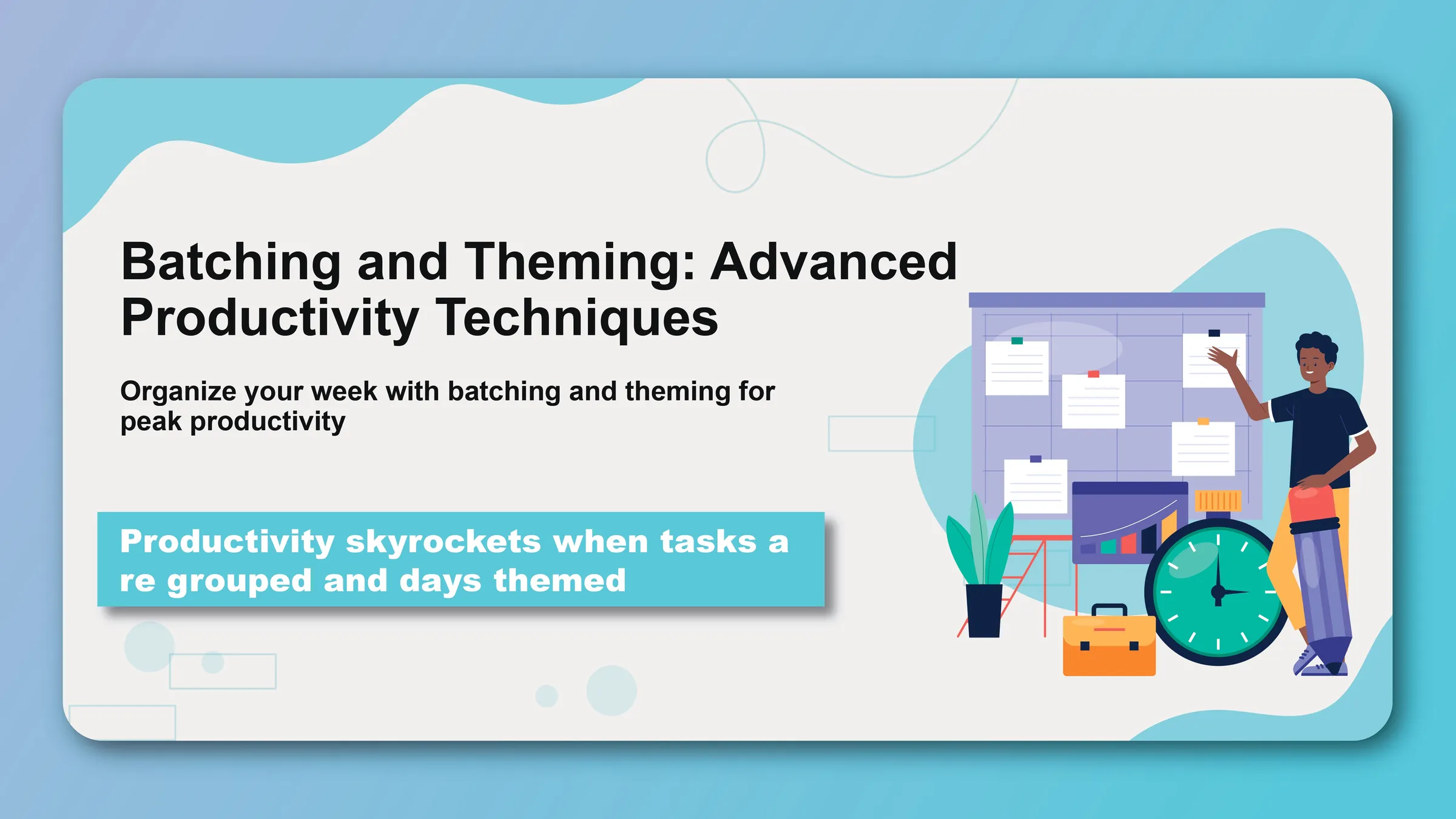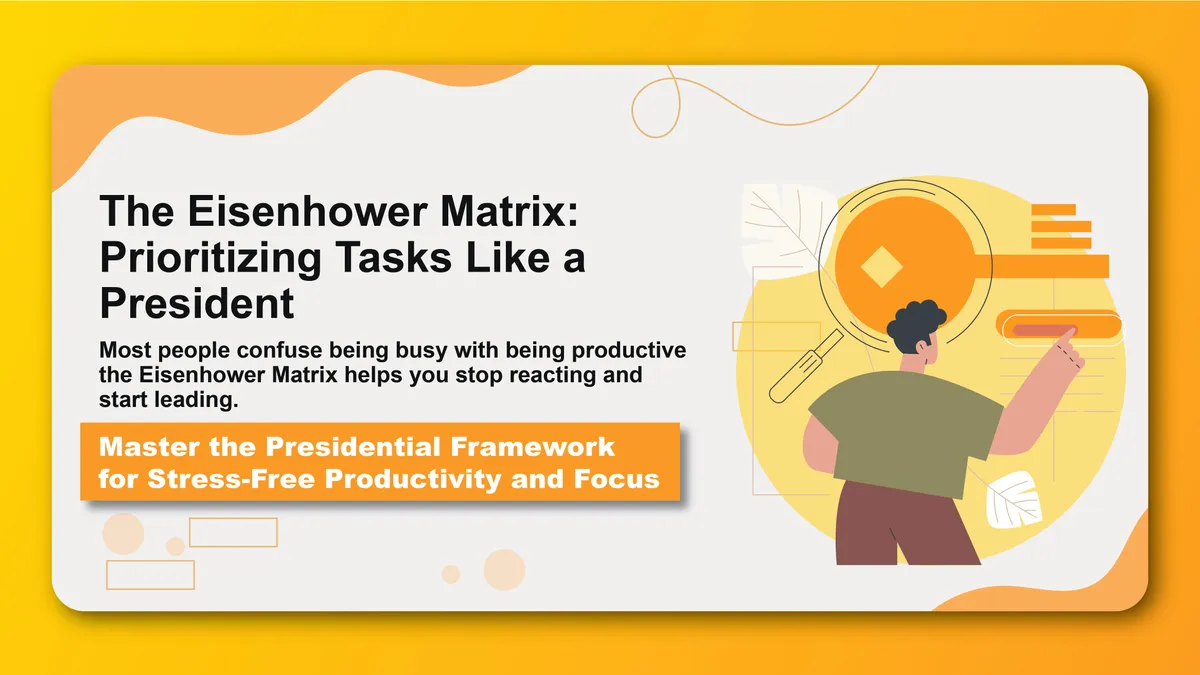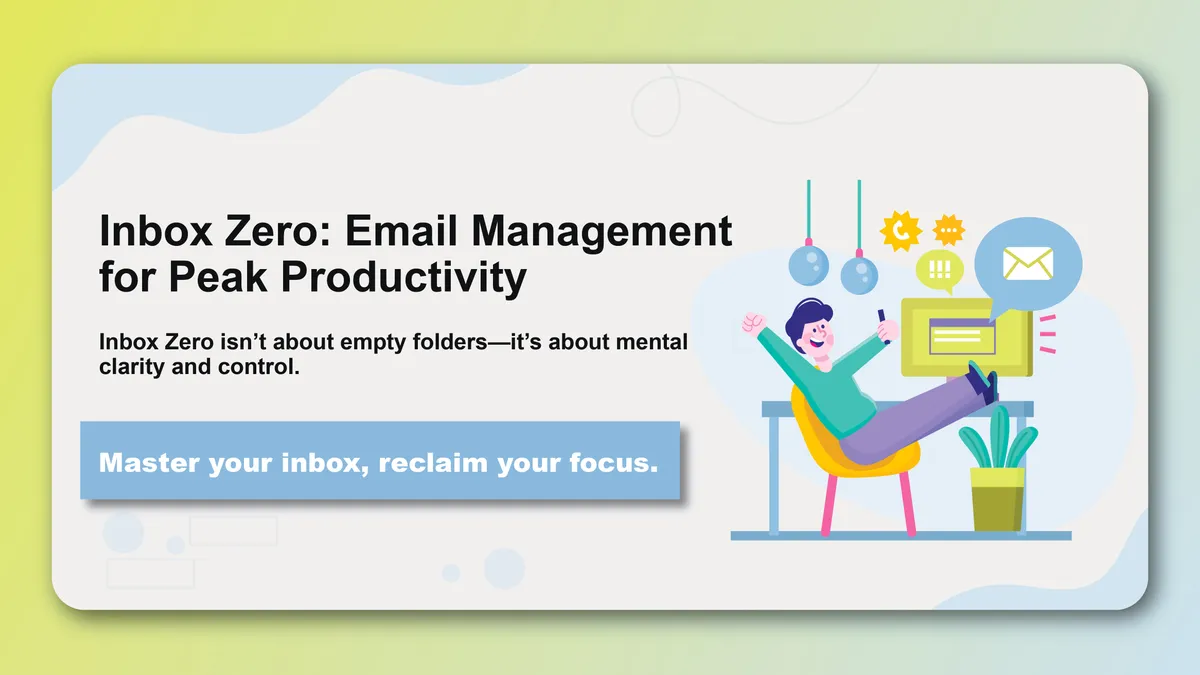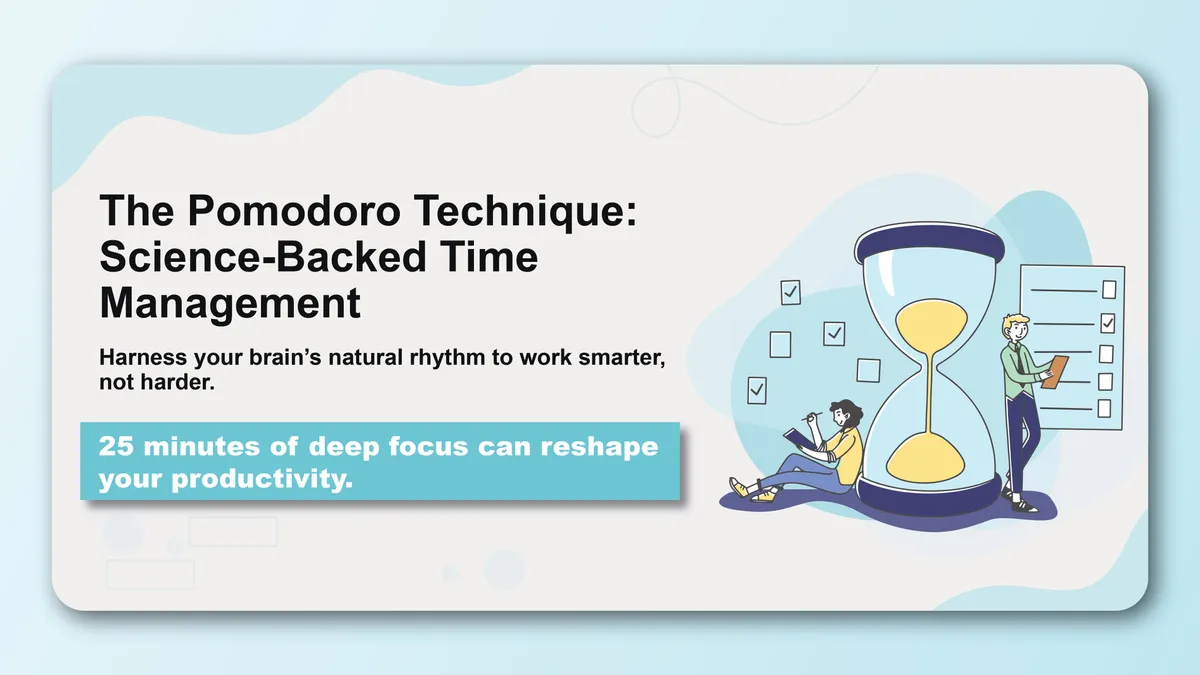In the constant battle against distraction and inefficiency, two powerful techniques have emerged as game-changers for high-performing individuals: task batching and day theming. These complementary strategies work by minimizing the hidden costs of context switching and maximizing your brain's ability to maintain focus on similar types of work.
While most people approach their days reactively, jumping from task to task as demands arise, masters of productivity strategically group similar activities together and organize their time around coherent themes. This approach doesn't just improve efficiency—it transforms the quality of your work and reduces the mental fatigue that comes from constant cognitive switching.
Understanding the Context Switching Cost
The Hidden Productivity Killer
Every time you switch from one type of task to another, your brain needs time to reorient itself. This "context switching cost" includes:
- Attention residue: Part of your focus remains on the previous task
- Cognitive reloading: Mental effort required to understand the new task
- Momentum loss: The time needed to regain productive flow
- Decision fatigue: Mental energy depleted from constantly choosing what to do next
Research shows that these switching costs can consume up to 40% of your productive time. A single interruption can take 23 minutes to fully recover from, and the average knowledge worker switches tasks every 3 minutes.
The Batching Solution
Task batching involves grouping similar activities together and completing them in dedicated time blocks. Instead of checking email throughout the day, you might process all messages in two 30-minute sessions. Rather than making calls sporadically, you dedicate a specific hour to all phone communications.
Day theming takes this concept further by assigning entire days or portions of days to specific types of work. Monday might be your "creative day," Tuesday your "meeting day," and Wednesday your "administrative day."
The Science Behind Batching and Theming
Cognitive Benefits
Reduced Mental Load When you batch similar tasks, you eliminate the mental overhead of constantly switching between different types of thinking. Your brain can settle into one mode of operation and maintain it efficiently.
Enhanced Flow States Batching creates longer periods of uninterrupted focus, making it easier to enter and maintain flow states where your performance is at its peak.
Improved Pattern Recognition Working on similar tasks consecutively helps your brain recognize patterns and develop more efficient approaches to recurring challenges.
Decreased Decision Fatigue By pre-deciding when you'll do different types of work, you reduce the number of micro-decisions throughout your day, preserving mental energy for important choices.
Neuroscience of Task Switching
Prefrontal Cortex Efficiency Your prefrontal cortex, responsible for executive function, works more efficiently when it can focus on one type of cognitive demand at a time.
Default Mode Network Batching allows your brain's default mode network to activate more predictably during transitions, leading to better creative insights and problem-solving.
Cognitive Load Theory By reducing the variety of information your working memory must handle simultaneously, batching improves your ability to process information deeply and accurately.
Task Batching Strategies
Communication Batching
Email Processing Instead of checking email constantly:
- Schedule 2-3 specific times per day for email
- Process emails in batches using the "2-minute rule"
- Use templates and canned responses for common inquiries
- Batch similar responses together
Phone Calls and Meetings
- Designate specific hours for phone calls
- Schedule meetings back-to-back when possible
- Group similar types of conversations
- Use batched prep time for multiple meetings
Social Media and Messaging
- Limit social media to specific time blocks
- Batch responses to messages and comments
- Use scheduling tools to post content in batches
- Process notifications in dedicated sessions
Creative Work Batching
Content Creation
- Write multiple articles in one session
- Batch research for several projects
- Create content outlines in focused blocks
- Edit and proofread in separate sessions
Design and Visual Work
- Group similar design tasks together
- Batch photo editing and graphic creation
- Dedicate blocks to brainstorming and ideation
- Separate creative work from revision work
Administrative Batching
Financial Tasks
- Process expenses and receipts weekly
- Batch invoice creation and sending
- Schedule financial planning sessions
- Group tax-related activities
Planning and Organization
- Batch weekly and monthly planning
- Group filing and organization tasks
- Schedule batch time for calendar management
- Process paperwork in dedicated sessions
Day Theming Frameworks
The Traditional Theme Day System
Monday: Strategic Planning
- Big picture planning and goal setting
- Project roadmap development
- Team alignment and vision work
- Strategic analysis and decision making
Tuesday: Creation and Deep Work
- Writing, design, and content creation
- Complex problem-solving
- Research and development
- Innovation and brainstorming
Wednesday: Communication and Collaboration
- Meetings and team collaboration
- Client calls and external communication
- Networking and relationship building
- Feedback and review sessions
Thursday: Operations and Maintenance
- Administrative tasks and paperwork
- System maintenance and updates
- Process improvement and optimization
- Routine operational work
Friday: Learning and Development
- Skill development and training
- Reading and research
- Course completion and studying
- Reflection and improvement planning
The Energy-Based Theming System
High-Energy Days
- Complex creative work
- Strategic decision making
- Challenging problem-solving
- Important presentations and meetings
Medium-Energy Days
- Routine operational tasks
- Communication and collaboration
- Planning and organization
- Skill practice and development
Low-Energy Days
- Administrative tasks
- Email and message processing
- Filing and organization
- Learning and consumption
The Project-Based Theming System
Project A Days
- All work related to primary project
- Deep focus on single initiative
- Minimal context switching
- Dedicated team and resources
Project B Days
- Secondary project focus
- Batch all related tasks
- Separate team and stakeholder communications
- Distinct deliverables and outcomes
Maintenance Days
- Ongoing operational tasks
- System and process maintenance
- Routine communications
- General administrative work
Advanced Batching Techniques
The Batch Matrix
Create a matrix organizing tasks by:
- Type of thinking required (creative, analytical, administrative)
- Energy level needed (high, medium, low)
- Tools and resources required (computer, phone, materials)
- People involved (solo work, team collaboration, external communication)
Micro-Batching
15-Minute Batches
- Quick email responses
- Brief phone calls
- Social media updates
- Short administrative tasks
30-Minute Batches
- Focused writing sessions
- Research and information gathering
- Planning and organization
- Skill practice
60-Minute Batches
- Deep work and complex tasks
- Extended creative sessions
- Important meetings
- Learning and development
Macro-Batching
Weekly Batches
- All meetings in 2-3 days
- Creative work clustered together
- Administrative tasks grouped
- Communication days separated
Monthly Batches
- All financial tasks in one week
- Strategic planning sessions
- Learning and development blocks
- Relationship building activities
Implementing Batching and Theming
Week 1: Assessment and Planning
Task Audit
- Track all tasks for one week
- Categorize by type and energy requirement
- Identify patterns and groupings
- Note context switching frequency
Time Analysis
- Record how much time is spent on different task types
- Identify peak performance times
- Note energy levels throughout the day
- Assess current scheduling efficiency
Week 2: Basic Batching
Start Small
- Choose one type of task to batch (e.g., email)
- Create specific time blocks for this task
- Eliminate scattered instances throughout the day
- Track the impact on productivity and stress
Expand Gradually
- Add one new batching category each day
- Group similar tasks together
- Create dedicated time blocks
- Monitor results and adjust as needed
Week 3: Day Theming
Choose Your System
- Select theming framework that matches your work
- Assign themes to each day of the week
- Create clear boundaries between themes
- Communicate your schedule to others
Test and Refine
- Try your theming system for one week
- Note what works and what doesn't
- Adjust themes based on your energy and work patterns
- Refine the system based on results
Week 4: Integration and Optimization
Combine Techniques
- Use both batching and theming together
- Create themed days with batched tasks
- Optimize for your specific work style
- Build in flexibility for urgent needs
Create Systems
- Develop templates and checklists
- Build batching into your planning process
- Create accountability measures
- Establish review and adjustment cycles
Overcoming Common Challenges
Challenge 1: Urgent Interruptions
The Problem: Important matters that can't wait for the next batch The Solution: Create interrupt protocols and emergency batches
Strategies:
- Define what constitutes a true emergency
- Create buffer time for urgent matters
- Develop quick assessment criteria
- Build flexibility into your batching system
Challenge 2: Resistance from Others
The Problem: Colleagues expect immediate responses and availability The Solution: Communicate your system and set clear expectations
Strategies:
- Explain the benefits of batching to your team
- Set clear response time expectations
- Provide alternative contact methods for emergencies
- Train others to batch their requests to you
Challenge 3: Perfectionism and Rigidity
The Problem: Trying to make the system perfect and inflexible The Solution: Start simple and build flexibility into your approach
Strategies:
- Begin with just one or two batching categories
- Allow for experimentation and adjustment
- Build in flexibility for unexpected needs
- Focus on progress, not perfection
Challenge 4: Motivation and Consistency
The Problem: Difficulty maintaining the system over time The Solution: Create supportive structures and accountability
Strategies:
- Track and celebrate improvements
- Create environmental supports
- Build accountability partnerships
- Regularly review and optimize your system
Advanced Batching Strategies
The Batch Hierarchy
Level 1: Basic Batching
- Group similar tasks together
- Create dedicated time blocks
- Eliminate scattered instances
- Focus on one task type at a time
Level 2: Smart Batching
- Optimize batch timing for energy levels
- Consider dependencies between tasks
- Use tools and templates for efficiency
- Build in buffer time and flexibility
Level 3: Strategic Batching
- Align batching with strategic goals
- Consider impact and importance
- Integrate with broader productivity systems
- Continuously optimize and refine
The Compound Batching Effect
Skill Development
- Batch similar learning activities
- Practice skills in focused blocks
- Group related skill development
- Create learning momentum
Relationship Building
- Batch networking activities
- Group similar types of communications
- Schedule relationship maintenance
- Create connection momentum
Creative Output
- Batch creative work for compound insights
- Group brainstorming and ideation
- Separate creation from editing
- Build creative momentum
Tools and Systems for Batching
Digital Tools
Calendar Management
- Color-code different types of batched work
- Block time for specific batch categories
- Set recurring batch schedules
- Use calendar analytics to optimize
Task Management
- Tag tasks by batch category
- Create batch-specific projects
- Use filters to view batched work
- Set up batch templates
Communication Tools
- Schedule email sending in batches
- Use auto-responders to set expectations
- Create communication templates
- Batch social media posting
Physical Systems
Workspace Organization
- Create dedicated spaces for different types of work
- Organize materials by batch category
- Use visual cues for batch types
- Design environment for minimal switching
Paper-Based Systems
- Use batch-specific notebooks
- Create batch checklists and templates
- Organize files by batch category
- Use physical timers for batch blocks
Measuring Batching Success
Productivity Metrics
Time Savings
- Measure reduction in context switching time
- Track increased focus periods
- Calculate efficiency gains
- Monitor task completion rates
Quality Improvements
- Assess work quality in batched vs. scattered work
- Measure error rates and rework
- Track creative output and insights
- Monitor stress levels and satisfaction
Long-term Benefits
Cognitive Health
- Reduced mental fatigue
- Improved focus and concentration
- Better decision-making ability
- Enhanced creativity and problem-solving
Professional Growth
- Increased productivity and output
- Better work quality and consistency
- Improved time management skills
- Enhanced strategic thinking ability
Your Batching and Theming Action Plan
Immediate Actions (This Week)
- Complete a task audit to identify batching opportunities
- Choose one task type to begin batching
- Create your first themed day
- Track the impact on your productivity and stress levels
Short-term Goals (Next Month)
- Implement batching for 3-4 different task types
- Establish a consistent day theming system
- Create supporting tools and templates
- Build accountability and review systems
Long-term Vision (Next Quarter)
- Develop advanced batching and theming strategies
- Integrate systems with broader productivity frameworks
- Optimize based on data and experience
- Share your system with others and build team practices
Batching and theming represent a fundamental shift from reactive to proactive time management. By grouping similar tasks and organizing your time around coherent themes, you can dramatically reduce the hidden costs of context switching while improving both the quality and quantity of your work.
Start with simple batching experiments, gradually introduce theming, and continuously refine your approach based on results. The investment in developing these systems will pay dividends in increased productivity, reduced stress, and higher quality output.
Ready to eliminate context switching and maximize your productivity? Organize your tasks and track your batching success with Habityzer and discover how strategic time organization can transform your performance.



